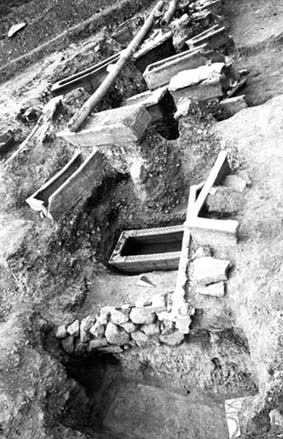

Resim 7. 1979-1982 yılları arasında kazılan Klazomenai Yıldıztepe Nekropolisi, üç ayrı evrede yapılmış çok sayıda gömüyü içermektedir. Geometrik dönemde de kullanılmış olan mezarlık alanında M.ö. 6. yüzyılın ikinci dörtlüğü başlarında yapılan düzenlemeyle pişmiş toprak Klazomenai lahitleri içine gömü yapılmasına başlandığı anlaşılmaktadır. Figürlerle zengin bir şekilde bezenmiş lahitlerin bu erken gömü evresine ait olması dikkat çeker. M.ö. 546da Pers istilası sonrasında kentle birlikte mezarlık alanı da terkedilmiş, aynı yüzyılın son dörtlüğü başlarında tekrar kullanıma açılarak yaklaşık 25 yıl gibi kısa bir süre içinde çok sayıda yeni gömü yapılmıştır. Figürlü ve figürsüz olarak bezenmiş lahitler yanısıra amphora ve pithos içine de gömü yapılmıştır. Mezarlığın son kullanımının M.ö. 5. yüzyıl sonlarında başladığı ve M.ö. 4. yüzyıl içinde sürdüğü anlaşılmaktadır.
Figure 7. Clazomenae Yıldıztepe Necropolis, excavated between 1979-1982 campaigns, has a great deal of graves in three different phases. It is obvious that the reorganisation of the necropolis area which had been used in the Geometric Period, was maintained at the beginning of the second quarter of the Sixth Century B.C. by using the terracotta Clazomenaean sarcophagi. It is interesting that those of sarcophagi, richly decorated with figures, belong to this early burial period. In 546 B.C., after the Persian invasion, the necropolis areas were abandoned at the same time with city. However, at the beginning of the last quarter of the century, the necropolis is reused with numerous burials over each other for 25 years. Apart from the sarcophagi decorated with figures or simple ornaments, there are amphorae and pithoi graves in this new using phase. It is clear that the last using of the necropolis started at the ending of the Fifth Century B.C. and continued during Fourth Century B.C.